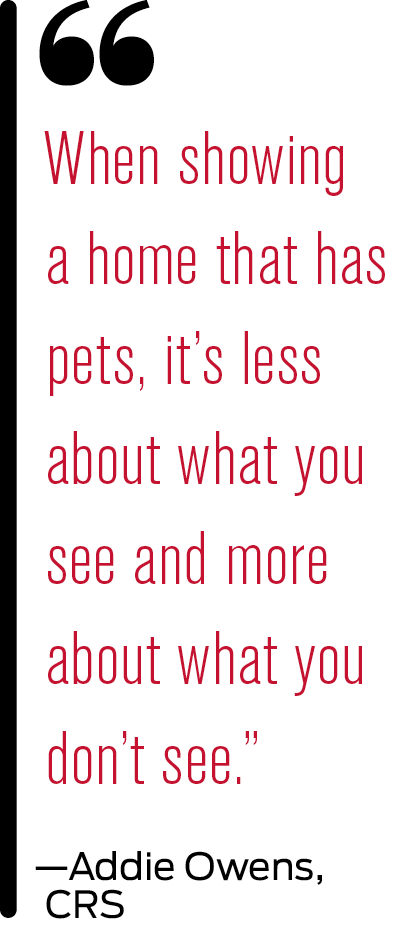Dealing with clients who own pets can present unique challenges for real estate agents and their marketing efforts
By Shaila Wunderlich
Fern Kulpreecha has moved six times over the past 14 years.

The RRC member and REALTOR® with Berkshire Hathaway HomeServices NorCal Real Estate in Granite Bay, California, always insisted on generous square footage, primary bedrooms on the main floor and quiet lots with plenty of space between neighbors. Yet even the properties that checked all these boxes could not earn her bid if they did not accommodate her three dogs and five cats. “I’m very particular about my fur babies’ well-being and whether they’re going to be happy and safe,” she says. “They’re my top concern when looking for a new home.”
On the flipside, you have the experience of broker Carrie Ives, CRS, with RE/MAX PRO in Amarillo, Texas. She’s discovered an overwhelming number of homebuyers who not only don’t want pets but prefer to see no evidence of them whatsoever in the homes they are viewing. Ives’ son, also a REALTOR®, recently worked with buyers who requested to view only properties that never housed animals. “Never until I became a REALTOR® did I realize how many people are either allergic to or deathly scared of pets,” Ives says.
According to Zillow’s 2021 Consumer Housing Trends Report, 46% of current homeowners have at least one dog, and 34% have at least one cat. NAR’s 2020 survey, “Pets in the Home Buying and Selling Process,” reported 43% of homeowners would be willing to move solely for the purpose of accommodating their pet.
Against such polarized, potentially deal-breaking preferences, how do REALTORS® walk the line? How does any given agent know whether to highlight—or hide—a property’s pet-related amenities?
1st, presume no pets
Generally speaking, the pet-loving side comes from a place of preference, while the pet-avoidant side comes from a place of safety and health. Because of this, it may make sense to initially cater to the latter. Supporting this strategy are the whopping 80% of REALTORS® who recommend their clients remove pets before showing a property. “Chances are good any buyer is a pet owner, but that doesn’t mean they want to smell or see signs of someone else’s pets,” says Addie Owens, CRS, principal broker with RE/MAX Touchstone in Florida’s Lake and Sumter Counties. “When showing a home that has pets, it’s less about what you see and more about what you don’t see.”
“If possible, remove the pet from the premises completely,” Ives says. “Even putting them in the kennel or backyard can be an issue. I’ve had several buyers who refused to even enter a room or yard if a pet was in it.”
Some other advice on how to prepare a home for showings include:
 Scrubbing floors, baseboards and walls. “My best staging advice to pet owners is clean, clean and clean some more,” Owens says. “So many pet owners become nose-blind to the smell of their animals—I know I do,” says Ives, a pet owner herself and wife of a veterinarian. “You may not detect that pet bed, but a nonpet person can smell it right when they walk in the door.”
Scrubbing floors, baseboards and walls. “My best staging advice to pet owners is clean, clean and clean some more,” Owens says. “So many pet owners become nose-blind to the smell of their animals—I know I do,” says Ives, a pet owner herself and wife of a veterinarian. “You may not detect that pet bed, but a nonpet person can smell it right when they walk in the door.”
Replacing or cleaning stained or smelly fabric. That includes carpets, drapes and upholstered furniture. Preferably remove or replace them. If that’s not possible, have them professionally cleaned. “As long as the buyer has noted any stains, another option would be to offer the buyer credit to have it cleaned or replaced themselves,” says Kulpreecha, who’s also a certified animal consultant.
Removing food bowls, leashes, pet beds and toys. “Store them in a shed or garage, which tend to have better ventilation than the interior of a home,” Ives says.
Ventilating. Open windows, if weather permits, and frequently check HVAC filters of listed houses, replacing if necessary.
2nd, prepare to pivot
Once the agent discovers a client in fact desires pets (whether on the disclosure form or by talking to them), they can shift gears to highlighting the home’s prime pet amenities. “I find that when you are dealing with a pet owner, they will usually bring it up within the first few minutes of talking to them,” Kulpreecha says. “Otherwise, I simply ask.”
This opens up a whole menu of selling points, which can be cherry-picked according to each property and each buyer’s preferences.
 Some of those selling points include:
Some of those selling points include:
Flat, fenced-in backyards. This was top of mind for Kulpreecha, as well as the most cited in NAR’s survey. “Be sure the fence is in decent condition, too,” she says. “Not falling down; no rust or gaps. You never want a potential buyer to look at something and consider it a potential repair.”
Single-level or ranch-style homes. Small dogs, in particular—especially those who like to stick at their owners’ heels—have difficulty navigating and staying safe on steep or excessive stairs.
Carpet or textured flooring. “Tile and laminate are popular, but their slick, shiny surface is hard for dogs and cats to walk on—they can slip and hurt their backs” Kulpreecha says. “It’s a personal preference that will differ from buyer to buyer.”
Pet-friendly zoning and HOAs. Most homeowner associations (HOAs) have rules and fees surrounding animals, including how many are allowed. The average annual association per-pet fee is $300, and many permit no more than two or three per residence. Rules regarding fencing and gates are also common.
3rd, consider the safety risks
Many of the things that pose risks to kids’ safety are interestingly also hazardous to pets. They include:
Water. Unsecured pools, ponds or landscaped water features pose drowning risks. “Pools should have fences to protect kids and pets,” Kulpreecha says.
Exposed drains, wires or electrical equipment.
Dangerous landscaping. Sharp edges, tiny crevices and poisonous plants are red flags to conscientious pet parents. “Hydrangeas and certain lilies can be toxic and even fatal to both humans and animals,” Kulpreecha says.
Lead paint and asbestos. “Asbestos is as harmful to fur babies as it is to humans,” she says. “Check the seller disclosure and inspection reports very closely. If there is question regarding any of the materials, or if the house was built before 1974, I’d recommend enlisting a certified contractor to come and inspect on top of the general inspection.”
Regardless of the buyer or the property, Kulpreecha says the most important thing is to listen and adjust accordingly. “My favorite thing to do is make note of all the ‘extras’ in pet amenities a home has to offer—things like doggy doors, covered patios and pet-proof insect screens—and be prepared to either highlight or downplay them according to the buyer’s tastes.”
Service animals are becoming more prevalent—get more guidance for your clients at ada.gov.
Photo: iStock.com/SeventyFour








